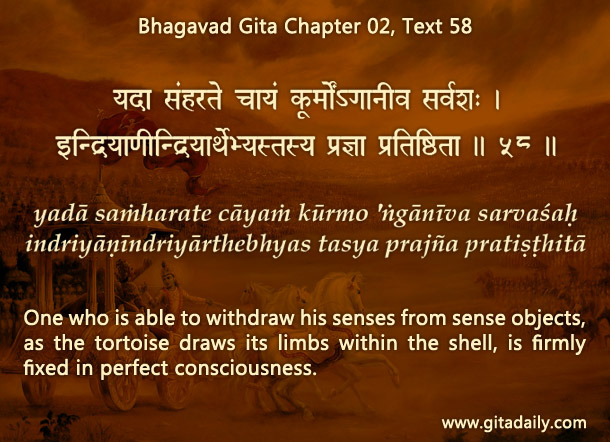(This article is presented in a question-answer format as an experiment to increase accessibility of content. Please share your feedback about this content through comments. Thank you.)
Question: Why does our mind sometimes get agitated for no reason?
Answer: Such agitation is often a cumulative expression of our pent-up frustration arising from our many desires that have been triggered but not fulfilled.
Question: What triggers such desires?
Answer: Exposure to tempting objects. While temptations can allure us through all the senses, they allure most frequently and often most aggressively through our eyes. And today’s culture with its multi-billion-dollar ad industry bombards us with visual temptations ceaselessly. When we see something good-looking, we crave for it. And because we can’t satisfy most such cravings, we start feeling dissatisfied, irritated, frustrated. Over time, this frustration accumulates, eventually bursting out as rage or seeping out as ennui. In such cases, we are often unable to pinpoint the cause of the agitation because the agitation is not immediately preceded by its cause.
Question: Then how can we know its cause?
Answer: From scripture and experience. The Bhagavad-gita (02.58) urges us to withdraw our senses from unnecessary interaction with sense objects, just as a tortoise withdraws its limbs into its shell. If we do this steadily for some time, we will find ourselves becoming calmer. By using our scripturally-guided intelligence to connect the decrease in mental agitation with the decrease in sensual temptation, we will recognize that the temptation had caused the agitation.
Question: But is withdrawing our senses practical? How can we function if we keep our eyes closed?
Answer: Yes, we need our eyes open to function, but they need to be focused where they serve a function, not distracted to wherever they find a temptation. To ensure that our senses function constructively, we need to avoid exposure to unnecessary temptations and minimize exposure to unavoidable temptations.
Such non-exposure can be done best by redirection. If we direct our visual hunger for pleasure towards Krishna by beholding his beautiful Deities, we will find ourselves become not just calmer but also happier.
To know more about this verse, please click on the image
Explanation of article:
Podcast:


Hari bol Prabhuji dandvat Pranam
I liked this format of commmentry very much as it has a very easy and direct approach to the related topic.
Thank you for the feedback – I will use it for the appropriate topics.
ys
ccdas
Hare Krishna prabhuji. Dandavat Pranam. All glories to Sri Prabhupada.
This is excellent idea. I loved it. You put contents in more easily understandable way.
Thank you, Kiran Prabhu, for the feedback.
ys
ccdas
hare krishna
It’s a good one,if you are considering it for some articles. But generally, your normal format is quite appealing and flow of the article remains continuous in the minds of the reader.So, for certain articles, this Q/A format may be a good option, but normally I would recommend to have a continuous flow of ideas, rather than breaking in forms of questions and answers.This would ensure the focus of the reader remains from start to end.
Thank you, Keshava Kashmiri Prabhu, for your thoughtful and valuable feedback. Yes, I have decided to use QA format for educational content and continue with the QA format for meditational content.
ys
ccdas
Hare Krishna,Prabhuji,
I find the article thoroughly explained and very helpful.
Dandvavat Pranam.
Thank you, Shantanu Prabhu.
ys
ccdas
This question-answer form of exposition helps us in a better way to understand the message of Lord Krishna. Your experiment is successful.
Thank you – As you are an authority on English, being an emeritus Professor, I especially value your feedback.
ys
ccdas
I have been reading your articles for an year. They contain wisdom which is not taught in any university and which no one talks about.
Thank You so much.
I like the new format of the article in the form Question and Answer.
Haribol!!
Thank you for the appreciation and feedback. Happy to be of service in sharing Krishna’s message.
ccdas
Hare Krishna CCD,
Thank you for another great insight into the how desires can lead to frustration, agitation,anger and ultimately, suffering.
Feedback on the Q & A style.
As an avid reader of your wisdom I find great satisfaction in your messages, in whatever style they are in, so thank you for that and long may it continue.
As an objective reader, there are two areas I can comment on.
Q&A format helps readers and students who are on the learning path and need a step by step explanation into the premise of the message. It sheds logical light at every step.
The previous style of messages are more in the style of prose. They are more natural and flow, creating mood and tense for the reader. It culminates in ending through an uninterrupted walk and there is satisfaction in that.
I will read both, from a retention point of view – in respect of a “thought of thr day style” the latter prose is better as we can dwell on it easier through out the day.
Respects and kind regards
Hare Krishna
??Paresh
Thank you for the insightful analysis. Yes, I too feel that the QA format is better for educational / analytical content than for inspirational / meditational content.
ys
ccdas
This is exactly what I was searching for and I got the answers through such a nicely presented Q&A format. Please continue to inspire us.
Hare Krsna prabhuji. Dandavats. The question and answer format is also clear and precise. However the previous format feel is more educational. Your humble servant, Kamal
Very nice format Prabhu..